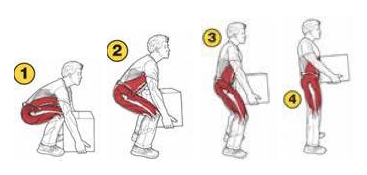(the following is taken from Stanford University EHS Ergonomics Website)
Before lifting or moving an object, assess the situation by asking the following questions:
- Is there equipment you can use to move the object (e.g. a hoist or hand truck)?
- If yes, use available equipment to safely move it.
- Is the object too heavy to lift by yourself?
- Lift one of the corners to assess the object’s weight.
- Determine if the object can be disassembled into smaller, more manageable parts.
- Recruit additional people to help you if necessary.
- When in doubt, don’t lift it without assistance.
- Is the object too awkward to carry?
- If yes, don’t lift it without assistance.
- How far do you have to carry the object?
- If you have to carry loads for a long distance, seek assistance.
- Is your carrying path free of debris, obstacles, and stairs? Is the surface of the path safe (i.e. not slippery)?
- Don’t try to carry loads across unsafe distances.
- Will your view be obstructed while carrying the object?
- Don’t attempt to carry loads if you cannot see where you are going.
- Use proper lifting technique.
If lifting by hand, use the “power position:”
- Stand with your feet approximately shoulder width apart, with one foot slightly in front of the other.
- Bend your knees slightly. Press your chest forward while maintaining your spine’s neutral curvature. Keep your head up.
- Get a good grip on the object.
- Contract the abdominal muscles and hold the object close to your body.
- Use your legs — not your back — to lift.
- Lift the object with a smooth movement (i.e. without jerking your body).

Carrying the object:
- Avoid twisting movements. Use your legs to turn (not your back).
- Hold the object close to your body, at waist level.
- If necessary, set the object down to rest.
Lowering the object:
- Contract your abdominal muscles while maintaining a neutral curve in your spine.
- Hold the object close to the body.
- While looking forward, bend your knees and slowly lower the object.
Additional tips:
- Take frequent breaks to interrupt repetitive lifting, mix in tasks that do not involve lifting, and take breaks to stretch.
- Use a stool or ladder to reach loads above your shoulders. Get as close to the load as possible before sliding it towards you. Work with your arms and legs — not your back.
- Take extra care with loads under racks or cabinets. Pull the load towards you, try to support the load on one knee before you lift, and use your legs to power the lift.
- Slide objects instead of lifting and carrying them.
- Push objects instead of pulling them.
- Plan tasks ahead of time to limit lifting and moving.
- Use hand trucks and push carts to assist with moving objects. For extremely heavy items, call on an authorized forklift operator.
- Design your workstation to avoid excessive bending, twisting, and stretching. Use tool supports for prolonged tool use.